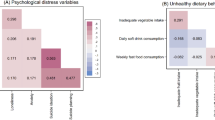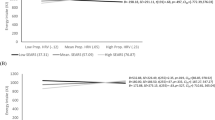Abstract
Objective:
To examine whether adolescent males and females who were victims of bullying were at greater risk of a higher body mass index (BMI) and obesity by young adulthood.
Design:
Secondary analysis of data from a community-based cohort study.
Subjects:
A sub-sample of 1694 offspring (50% males) who were participants in the Mater-University of Queensland Study of Pregnancy (MUSP), Brisbane, and who provided bullying information at 14 years and physical assessment at 21 years.
Main Outcome Measures:
BMI and its categories as normal, overweight or obese at 21 years.
Results:
One in two adolescent males and one in three adolescent females reported that they had been bullied at school by others. We found that adolescent males and females who were bullied were at a significantly greater risk of a higher BMI and obesity by young adulthood. Fourteen-year-old males who were occasionally/often bullied at school had 0.64 (95% confidence interval (CI): 0.02, 1.27) kg m2 greater mean BMI by 21 years compared with males who were never bullied by 14 years. This mean difference in BMI was 1.52, (95% CI: 0.75, 2.29) kg m2 for females. Similarly, the odds of being obese were 2.54 (95% CI: 1.58, 4.09) times at 21 years for those males who were bullied occasionally/often compared with adolescent males who were never bullied. For females, this was 2.18 (95% CI: 1.40, 3.39). Overweight adolescents who experienced bullying had the greatest increase in BMI by young adulthood. Adjusting for potential confounding or mediating factors, the associations remain strong for males but are attenuated for females.
Conclusions:
The findings of this study suggest that both male and female adolescents who were bullied often/sometimes by their peer group at 14 years were at greater risk of higher BMI and obesity by young adulthood.
This is a preview of subscription content, access via your institution
Access options
Subscribe to this journal
Receive 12 print issues and online access
$259.00 per year
only $21.58 per issue
Buy this article
- Purchase on Springer Link
- Instant access to full article PDF
Prices may be subject to local taxes which are calculated during checkout
Similar content being viewed by others
References
Anderson PM, Butcher KE . Childhood obesity: trends and potential causes. Future Child 2006; 16: 19–45.
Wang Y, Lobstein T . Worldwide trends in childhood overweight and obesity. Int J Pediatr Obes 2006; 1: 11–25.
Janssen I, Craig WM, Boyce WF, Pickett W . Associations between overweight and obesity with bullying behaviors in school-aged children. Pediatrics 2004; 113: 1187–1194.
Griffiths LJ, Wolke D, Page AS, Horwood JP . Obesity and bullying: different effects for boys and girls. Arch Dis Child 2006; 91: 121–125.
Pearce MJ, Boergers J, Prinstein MJ . Adolescent obesity, overt and relational peer victimization, and romantic relationships. Obes Res 2002; 10: 386–393.
Kraig KA, Keel PK . Weight-based stigmatization in children. Int J Obes 2001; 25: 1661–1666.
Irshad H, Edmundson E . Psychosocial correlates of physical activity vs correlates of sedentary behavior among adolescents: Implications for measuring antecedents of adolescent obesity. Ann Behav Med 2008; 35: S163–S163.
Lumeng JC, Forrest P, Appugliese DP, Kaciroti N, Corwyn RF, Bradley RH . Weight status as a predictor of being bullied in third through sixth grades. Pediatrics 2010; 125: E1301–E1307.
Griffiths LJ, Wolke D, Page AS, Horwood JP, Team AS . Obesity and bullying: different effects for boys and girls. Arch Dis Child 2006; 91: 121–125.
Matthews KA, Midei AJ . Interpersonal violence in childhood as a risk factor for obesity: a systematic review of the literature and proposed pathways. Obes Rev 2011; 12: e159–e172.
Puhl RM, Heuer CA . Obesity stigma: important considerations for public health. Am J Public Health 2010; 100: 1019–1028.
Sweeting H, Wright C, Minnis H . Psychosocial correlates of adolescent obesity, ‘slimming down’ and ‘becoming obese’. J Adolesc Health 2005; 37: 409.
Adams RE, Bukowski WM . Peer victimization as a predictor of depression and body mass index in obese and non-obese adolescents. J Child Psychol Psychiatry 2008; 49: 858–866.
Najman JM, Bor W, O’Callaghan M, Williams GM, Aird R, Shuttlewood G . Cohort profile: The Mater-University of Queensland study of pregnancy (MUSP). Int J Epidemiol 2005; 34: 992–997.
Keeping JD, Najman JM, Morrison J, Western JS, Andersen MJ, Williams GM . A prospective longitudinal study of social, psychological and obstetric factors in pregnancy: response rates and demographic characteristics of the 8556 respondents. Br J Obstet Gynaecol 1989; 96: 289–297.
Hammen C, Brennan PA . Depressed adolescents of depressed and nondepressed mothers: tests of an interpersonal impairment hypothesis. J Consult Clin Psychol 2001; 69: 284–294.
Cole TJ, Bellizzi MC, Flegal KM, Dietz WH . Establishing a standard definition for child overweight and obesity worldwide: international survey. BMJ 2000; 320: 1240–1243.
World Health Organization. Obesity. Preventing and Managing the Global Epidemic. Report of a WHO Consultation on Obesity 3-5 June 1997 World Health Organization: Geneva, Switzerland 1998.
Hernan MA, Hernandez-Diaz S, Werler MM, Mitchell AA . Causal knowledge as a prerequisite for confounding evaluation: an application to birth defects epidemiology. Am J Epidemiol 2002; 155: 176–184.
Achenbach TM . Integrative Guide for the 1991 CBCL/4-18, YSR, and TRF Profiles. Department of Psychiatry, University of Vermont: Burlington, Vt., 1991.
Tanner JM . Growth at Adolescence; with A General Consideration of the Effects of Hereditary and Environmental Factors Upon Growth and Maturation from Birth to Maturity 2nd edn. Springfield, Ill, 1962.
Morris NM, Udry JR . Validation of a self-administered instrument to assess stage of adolescent development. J Youth Adolescence 1980; 9: 271–280.
Bowman SA, Gortmaker SL, Ebbeling CB, Pereira MA, Ludwig DS . Effects of fast-food consumption on energy intake and diet quality among children in a national household survey. Pediatrics 2004; 113: 112–118.
Otten JJ, Littenberg B, Harvey-Berino JR . Relationship between self-report and an objective measure of television-viewing time in adults. Obesity 18: 1273–1275.
Mackinnon DP, Dwyer JH . Estimating mediated effects in prevention studies. Evaluation Rev 1993; 17: 144–158.
Kaltiala-Heino R, Marttunen M, Rantanen P, Rimpela M . Early puberty is associated with mental health problems in middle adolescence. Soc Sci Med 2003; 57: 1055–1064.
Ge X, Conger RD, Elder GH . Coming of age too early: pubertal influences on girls’ vulnerability to psychological distress. Child Dev 1996; 67: 3386–3400.
Mamun AA, Hayatbakhsh MR, O’Callaghan M, Williams G, Najman J . Early overweight and pubertal maturation--pathways of association with young adults’ overweight: a longitudinal study. Int J Obes 2009; 33: 14–20.
Liu X, Kaplan H . Explaining gender differences in symptoms of subjective distress in young adolescents. Stress Med 1999; 15: 41–51.
Farhat T, Iannotti RJ, Simons-Morton BG . Overweight, obesity, youth, and health-risk behaviors. Am J Prev Med 2010; 38: 258–267.
Olweus D . Bullying at school: long-term outcomes for the victims and an effective school-based intervention program. In: Huesmann LR, (ed). Aggressive behavior: current perspectives. Plenum Press: New York, 1994. pp 97–130.
Robinson JP, Shaver PR, Wrightsman LS. 1991. Measures of personality and social psychological attitudes. Academic Press: San Diego, CA.
Alati R, Al Mamun A, Williams GM, O’Callaghan M, Najman JM, Bor W . In utero alcohol exposure and prediction of alcohol disorders in early adulthood: a birth cohort study. Arch Gen Psychiatry 2006; 63: 1009–1016.
Horwood LJ, Fergusson DM, Hayatbakhsh MR, Najman JM, Coffey C, Patton GC et al. Cannabis use and educational achievement: findings from three Australasian cohort studies. Drug Alcohol Depen 2010; 110: 247–253.
Acknowledgements
The authors thank the National Health and Medical Research Council and National Heart Foundation for funding this project. AAM was supported by a National Health and Medical Research Council Career Development Awards for this work. The views expressed in this paper are those of the authors and not necessarily any funding body. The authors had full access to all data, and no funding bodies influenced the analysis or interpretation of results. The authors thank the Mater-University of Queensland Study of Pregnancy team, the Mater Misericordiae Hospital and the Schools of Social Science and Population Health at the University of Queensland for their support. They specifically thank members of the Mater-University of Queensland Study of Pregnancy 21-Year follow-up team, including Rosemary Aird, Stacey Allerton, Ruth Armstrong, Samantha Batchelor, Pauline Bonnici, Rachael Bor, Emma Brown, Justine Butcher, Fiona Cameron, Narelle Constantine, Sophie Gudgeon, Jatinder Kaur, Jane Maclean, Amanda Margerison, Kobie Mulligan, Kelly Quinlan, Marie Seeman and Jennifer Winn.
Author information
Authors and Affiliations
Corresponding author
Ethics declarations
Competing interests
The authors declare no conflict of interest.
Rights and permissions
About this article
Cite this article
Mamun, A., O'Callaghan, M., Williams, G. et al. Adolescents bullying and young adults body mass index and obesity: a longitudinal study. Int J Obes 37, 1140–1146 (2013). https://doi.org/10.1038/ijo.2012.182
Received:
Revised:
Accepted:
Published:
Issue Date:
DOI: https://doi.org/10.1038/ijo.2012.182
Keywords
This article is cited by
-
Body mass index and bullying victimization as antecedents for depressive symptoms in a Swedish youth cohort
Journal of Public Health (2022)
-
Emotion Identification in Preschool and Early Adolescent Body Mass Index: Exploring the Roles of Depressive Symptoms and Peer Relations
Child Psychiatry & Human Development (2020)
-
An Examination of Bullying and Physical Health Problems in Adolescence among South Korean Youth
Journal of Child and Family Studies (2019)
-
Breakfast Skipping, Psychological Distress, and Involvement in Bullying: Is There a Connection?
International Journal of Bullying Prevention (2019)
-
Association between body mass index and health outcomes among adolescents: the mediating role of traditional and cyber bullying victimization
BMC Public Health (2018)



